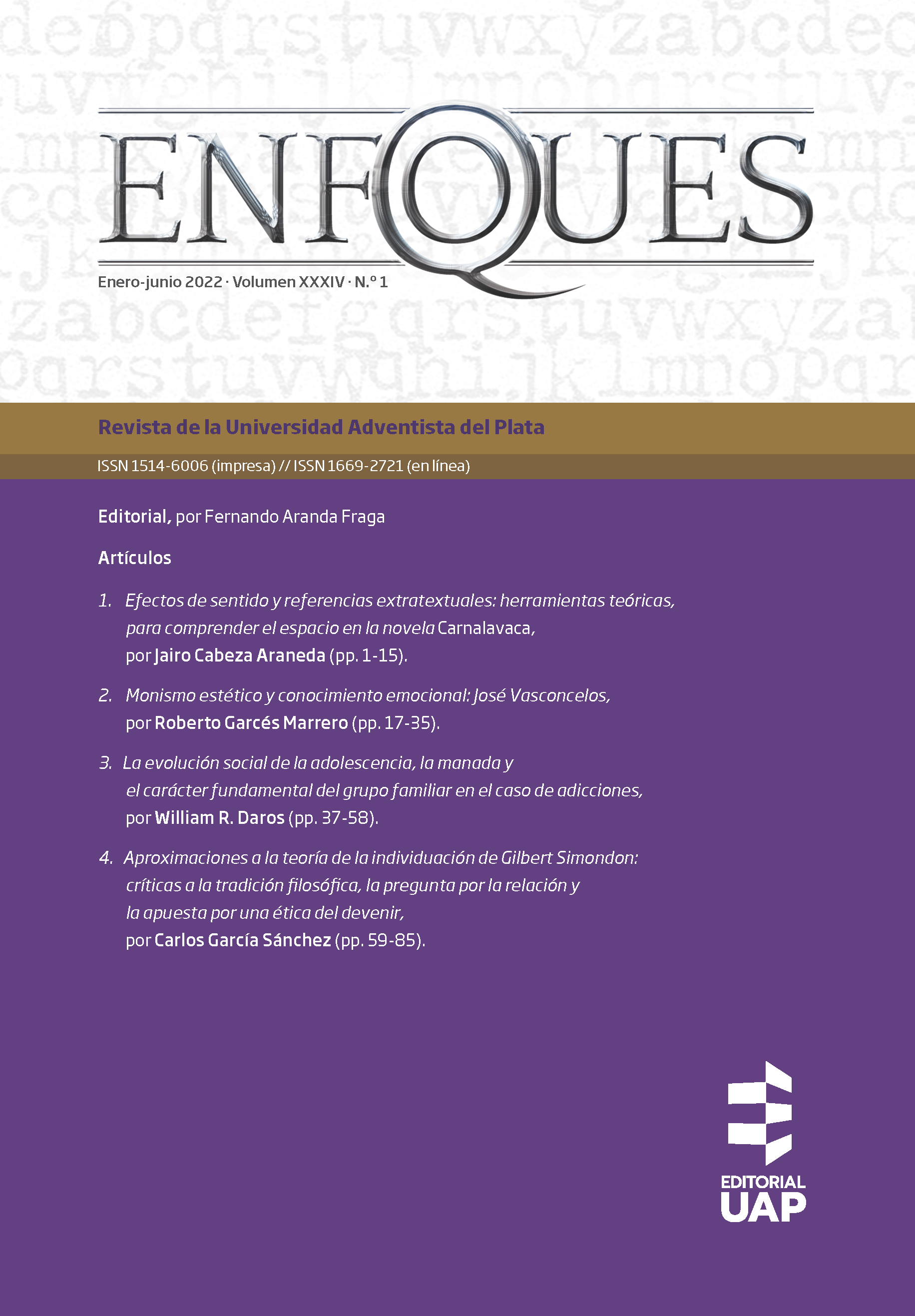La evolución social de la adolescencia, la manada y el carácter fundamental del grupo familiar en el caso de adicciones
DOI:
https://doi.org/10.56487/enfoques.v34i1.1030Palabras clave:
Evolución — Adolescencia — Grupo familiar — MadurezResumen
En este breve ensayo, se trata de exponer el hecho de la evolución de la adolescencia,actualmente enfocada en una manada atomizada de individuos inmersos en lacultura visual y multimedia que centralizan sus acciones de consumo en dispositivosde pantalla. De la cultura del libro se ha pasado a la cultura de la imagen propia.La “curación” de la adolescencia (adolecer) y del refugio en la manada implican elpaso del tiempo y la maduración reflexiva que este puede traer; implican tolerarel no saber a dónde ir para adquirir el sentido de vivir en una sociabilización adecuaday con autonomía. La carencia de sentido en la vida produce aburrimientoy fastidio para quien busca placer que frecuentemente confunde con felicidad.La pérdida de la figura del varón como protector ocasiona frecuentes crisis en laestructura familiar. La falta de empleo significa la ausencia de pertenencia. Aun así,numerosos adolescentes reaccionan proponiéndose quijotescamente realizar algogrande con sus vidas. La historia está hecha de grandes personas que se hicieron apesar de los ambientes adversos.Descargas
Citas
Manuel Castells, “El poder en la sociedad red”, Comunicación y poder (España: Alianza, 2010).
Luis Miguel y Pedrero-Esteban, “Adolescentes, smartphones y consumo de audio digital en la era de Spotify”, Comunicar 60, n.o 1 (2019): 237-274.
Cf. Teresa Osojnik, “La continuidad de la vida”, Prevención de adicciones (Buenos Aires: Pro-Ciencia CONICET, 1995).
Carlos Iván García Suárez y Doris Amparo Parada Rico, “‘Construcción de adolescencia’: una concepción histórica y social inserta en las políticas públicas”, Universitas Humanística 85 (2018), http://www.redalyc.org/articulo.oa?id=79157276013.
Cf. William R. Daros, “La invisibilidad de los deberes humanos universales”, Enfoques 25, n.o 2 (2013): 9-31.
Cf. Gilles Lipovetsky y Jean Serroy, La pantalla global: cultura mediática y cine en la era hipermoderna (Barcelona: Anagrama, 2009). María José Fernández-Serrano, Laura Moreno-López, Miguel Pérez-García y Antonio Verdejo-García, “Inteligencia emocional en individuos dependientes de cocaína”, Trastornos Adictivos 14, n.o 1 (2012): 27-33.
Osojnik, “La continuidad de la vida”, 25.
Piera Castoriadis-Aulagnier. La violencia de la interpretación: el estado de encuentro y el concepto de violencia (Buenos Aires: Amorrortu Editores, 2019).
Miguel Carbonero et al., European Journal of Education and Psychology 3, n.º 2 (2010): 287-298.
Cf. Donald W. Winnicott, “Enfoque clínico de los problemas familiares: la familia”, parte 3, cap. 7, Acerca de los niños (Buenos Aires: Paidós, 2017); Donald W. Winnicott, Deprivación y delincuencia (Buenos Aires: Paidós, 2019); Daniel Míguez, Los pibes chorros: estigma y marginación (Buenos Aires: Editorial Capital Intelectual, 2014).
Román Tarapués y Estefanía Diana, “Influencia del tipo de vínculo afectivo materno y paterno, en la conducta agresiva de los adolescentes”, http://www.dspace.uce.edu.ec/bitstream/25000/7588/1/T-UCE-0007-283c.pdf; Nathalie Vargas, Carol Castellanos y Ana María Villamil, “Resistencia a la presión de grupo”, Boletín Electrónico de Salud Escolar 1, n.o 1 (2015), http://www.tipica.org/media/system/articulos/vol1N1/12_e_resistencia_a_la_presion_de_grupo.pdf.
Gustave Le Bon, Psicología de las masas (Biblioteca digital en línea, 1895), https://libroweb.wordpress.com/2007/10/12/gustave-le-bon-psicologia-de-las-masas-lebon/.
Bertrand Russel, Sobre la educación (Epub, junio de 2013), 38.
Eduardo J. Pedrero Pérez, Neurociencia y adicción (Madrid: Sociedad Española de Toxicomanías, 2019), 29.
Winnicott, “Enfoque clínico de los problemas familiares”, 1959, http://www.psicopsi.com/Enfoque_clinico_de_los_problemas_familiares_la_familia_1959-asp/ .
Cf. Hugo Antonio Arroyo et. al., Salud y bienestar de adolescentes y jóvenes: una mirada integral. Comp. por Diana Pasqualini y Alfredo Llorens (Buenos Aires: Organización Panamericana de la Salud, 2010), 70-71.
Cf. Eduardo J. Pérez, Neurociencia y adicción (Madrid: Sociedad Española de Toxicomanías, 2019), 50.
Cf. Consuelo Tomás Benloch, “Me estoy obsesionando con mi imagen. ¿Dónde están los límites?”, Instituto Valenciano de Ludopatía y Adicciones no Tóxicas (2018), http://adiccionesvalencia.es/me-estoy-obsesionando-con-mi-imagen-donde-estan-los-limites/.
Publicado
Número
Sección
Licencia

Esta obra está bajo una licencia internacional Creative Commons Atribución-NoComercial-CompartirIgual 4.0.




